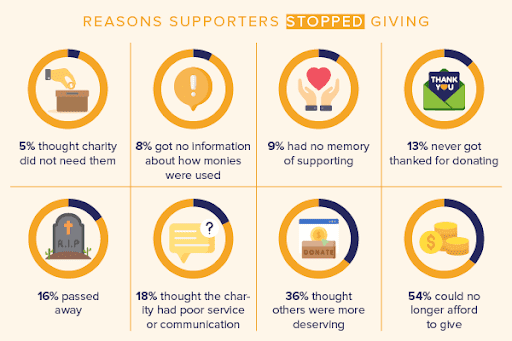A guest post from Ann Fellman at Bloomerang
Picture this: You receive a letter in the mail from a nonprofit to which you recently donated. The letter reads, “Dear Donor, Thank you for your generous donation. It’s because of your support that we’re able to achieve our mission.”
How do you react?
You appreciate the thanks, but find it to be a little generic and bland. Plus, the letter doesn’t say anything specific about how the organization used your gift or how you can stay in touch.
Now, let’s switch hats from donor to nonprofit. As a nonprofit professional, you want to make your organization’s thank-you letters memorable and meaningful, whether they’re going to donors or volunteers. But how can you make your supporter communications stand out? Follow these five tips to get started:
1. Send your thank you letters as soon as possible.
Sending out thank you messages as quickly as possible after supporters interact with your organization ensures that you won’t accidentally overlook the thank you process. Plus, it leaves a positive impression on supporters and keeps your nonprofit on their radar.
Whether donors give online, in person, or via direct mail, send a thank you letter right away. This letter should be separate from the automated donation receipt that you email donors right after they give. Take the time to craft a personalized, detailed thank you message and send it within 48 hours of receiving the donation.
If your nonprofit has a large support base, you can automate the thank you process using your donor management system. According to Bloomerang’s donor management software guide, robust donor database systems allow you to keep track of donors’ names and donation history using contact records and profiles. Then, when you use a CRM that has an integrated email marketing system, you can automatically plug donors’ names and donation amounts into each message. This keeps all your data and communications organized in one simplified database.
In addition, you should quickly send thank you notes after your volunteer opportunities. Follow up within a couple of days thanking volunteers for their hard work and recapping what they were able to accomplish during the volunteer opportunity.
2. Personalize each thank you letter.
A personalized letter catches the recipient’s attention, helping your letter stand out in their mailbox or email inbox. Use the information stored in your donor management system to personalize your thank-you notes with donors’ names.
However, personalization doesn’t mean just including each supporter’s name in your greeting. It also means referencing each supporter’s exact contributions to your cause and if possible the campaign or program they supported.
For example, you should thank a donor for their $78 gift sent on November 18, 2022 to your annual fund, or a volunteer for the three hours they spent sorting donated food on a Saturday morning.
Supporters will appreciate that you’ve taken the time to identify and recognize the specific ways they’ve advanced your mission.
3. Provide a compelling progress update.
Saying thank you to donors is powerful, but it’s even more powerful when you explain to them that your organization couldn’t propel its mission without their help.
Make sure your thank you notes show donors how their gifts made a positive impact on your cause. Describe the project or program that you were able to improve with their help.
For example, you might say, “Because of your $30 donation, a local elementary school student will be able to receive a brand new school backpack.”
It’s helpful to write your thank you letter in the form of a story. Stories help create emotional connections and bring your mission to life for donors and volunteers.
Meyer Partners’ guide to nonprofit storytelling recommends identifying a single protagonist and telling their story using interviews, images, and videos. These multimedia elements help donors and volunteers feel much more connected to your mission and those you work with in the community.
4. Handwrite your thank-you notes.
Amid the piles of junk mail your supporters likely receive in their mailboxes, a handwritten thank you note stands out and provides a personal touch. Supporters will be touched that you took the time to write out your gratitude using pen and paper.
It may not be feasible to handwrite thank you letters for every donor or volunteer, so you might focus your efforts on writing notes for long-time supporters.
Also, if you have a lot of letters to write, you can have your donor database generate your letters and leave a space for a short handwritten, personalized note. For instance, you might include a handwritten P.S. that says something like “Thanks, Josh for your support, it means the world to us!”
5. Highlight additional ways to get involved.
Show supporters that you appreciate their involvement, no matter the form it takes, by inviting them to engage with your organization in more ways than one.
For example, use your thank you note to highlight opportunities like:
- Your annual peer-to-peer fundraiser walkathon event
- A recurring weekend volunteer opportunity
- A supporter appreciation gala
- An advocacy letter-writing campaign
Also, invite supporters to connect with you on multiple platforms by following your social media pages or subscribing to your email newsletter.
As you can see, an effective appreciation letter requires a little more than just a simple “thank you.” With the right timing, thoughtfulness, and personalization, your supporter thank you letters can be a powerful tool for building stronger relationships and bringing in reliable support for your fundraisers, volunteer opportunities, and other initiatives.
As the Chief Marketing Officer at Bloomerang, Ann is responsible for the company’s overall thought leadership, brand, marketing, and community outreach programs that work to strengthen relationships with customers and the broader nonprofit community. Ann brings with her more than 24 years of experience in business-to-business (B2B) marketing in the technology industry, including time spent working at a nonprofit organization.



